Notes
- ↑ Robert Simpson Flute Concerto - Full score, published by Rosehill Music
The Flute Concerto by Robert Simpson was composed in 1989 and dedicated to Susan Milan, the flautist who commissioned the work and gave its premiere in May 1992 at the Malvern Festival with the City of London Sinfonia conducted by Richard Hickox.
The work is in one movement with a running time of approximately twenty-five minutes. The orchestra used by Simpson is a small one, with seven woodwind players, two horns, timpani and strings. The work can broadly be divided into three distinct parts: [1]
In a 6/8 meter, the work begins with a phrase from muted first violins that forms the basis of the entire work. The shape given out by the sequence of intervals present in A - B - C♯ - D♯ - D - D♯ - B - C - D is developed throughout the entire one movement structure. The flute enters several bars later with a variation on this phrase with light accompaniment from the orchestra, often consisting of just a single line with the dynamic level remaining at pianissimo for a considerable period of time. After several minutes a climax is reached, leading into a brief secondary part of the Allegretto where the tempo remains the same but the meter is changed to common time. Gradually the music becomes more agitated before breaking away into the following section, Allegro non troppo.
A one-in-a-bar scherzo, it begins softly with strings before the flute enters, accompanied by chamber-like subdued textures from the orchestra. The soloist has dialogue with both the woodwinds and the timpani during this section, giving the impression of dry wit. This section too climaxes near its end, before ending softly and mysteriously, leading into the final Adagio.
The strings introduce the Adagio, its mood contemplative and introspective (reminiscent of some of the slow string writing in Simpson's Ninth Symphony and later string quartets). The flute and woodwinds take over this theme in turn. After a passage accompanied by divided cellos, the work reaches its final, extended climax as the flautist is instructed to sit with the string soloists for the very final part of the piece where the conductor is required to sit out. The last five minutes are essentially chamber music - the flute and string soloists forming a quintet, closing peacefully.

Orchestration is the study or practice of writing music for an orchestra or of adapting music composed for another medium for an orchestra. Also called "instrumentation", orchestration is the assignment of different instruments to play the different parts of a musical work. For example, a work for solo piano could be adapted and orchestrated so that an orchestra could perform the piece, or a concert band piece could be orchestrated for a symphony orchestra.
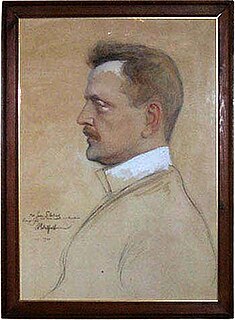
The Violin Concerto in D minor, Op. 47 of Jean Sibelius, originally composed in 1904 and revised in 1905, is the only concerto by Sibelius. It is symphonic in scope, with the solo violin and all sections of the orchestra being equal voices. An extended cadenza for the soloist takes on the role of the development section in the first movement.
The Cello Concerto No. 1 in E-flat major, Op. 107, was composed in 1959 by Dmitri Shostakovich. Shostakovich wrote the work for his friend Mstislav Rostropovich, who committed it to memory in four days and gave the premiere on October 4, 1959, with Yevgeny Mravinsky conducting the Leningrad Philharmonic Orchestra in the Large Hall of the Leningrad Conservatory. The first recording was made in two days following the premiere by Rostropovich and the Moscow Philharmonic, under the baton of Aleksandr Gauk.
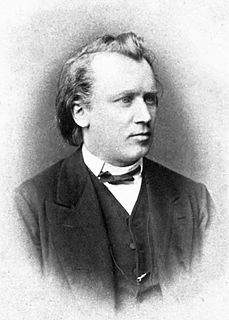
The Symphony No. 1 in C minor, Op. 68, is a symphony written by Johannes Brahms. Brahms spent at least fourteen years completing this work, whose sketches date from 1854. Brahms himself declared that the symphony, from sketches to finishing touches, took 21 years, from 1855 to 1876. The premiere of this symphony, conducted by the composer's friend Felix Otto Dessoff, occurred on 4 November 1876, in Karlsruhe, then in the Grand Duchy of Baden. A typical performance lasts between 45 and 50 minutes.
Sergei Prokofiev set to work on his Piano Concerto No. 2 in G minor, Op. 16, in 1912 and completed it the next year. But that version of the concerto is lost; the score was destroyed in a fire following the Russian Revolution. Prokofiev reconstructed the work in 1923, two years after finishing his Piano Concerto No. 3, and declared it to be "so completely rewritten that it might almost be considered [Piano Concerto] No. 4." Indeed its orchestration has features that clearly postdate the 1921 concerto. Performing as soloist, Prokofiev premiered this "No. 2" in Paris on 8 May 1924 with Serge Koussevitzky conducting. It is dedicated to the memory of Maximilian Schmidthof, a friend of Prokofiev's at the Saint Petersburg Conservatory who had killed himself in 1913.
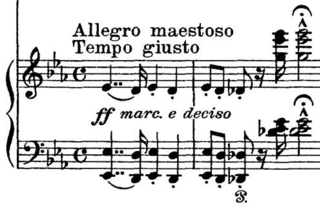
Franz Liszt composed his Piano Concerto No. 1 in E♭ major, S.124 over a 26-year period; the main themes date from 1830, while the final version is dated 1849. The concerto consists of four movements and lasts approximately 20 minutes. It premiered in Weimar on February 17, 1855, with Liszt at the piano and Hector Berlioz conducting.

The Symphony No. 3 in C major, Op. 52, by Jean Sibelius is a symphony in three movements composed in 1907. Coming between the romantic intensity of Sibelius's first two symphonies and the more austere complexity of his later symphonies, it is a good-natured, triumphal, and deceptively simple-sounding piece. The symphony's first performance was given by the Helsinki Philharmonic Society, conducted by the composer, on 25 September 1907. In the same concert, his suite from the incidental music to Belshazzar's Feast, Op. 51, was also performed for the first time. It is dedicated to the British composer Granville Bantock, an early champion of his work in the UK.
Fantasy on Japanese Woodprints, Op. 211 (1965), is a concerto in one movement written for xylophone and orchestra by the Armenian-American composer Alan Hovhaness.
The Strathclyde Concertos are a series of ten orchestral works by the English composer Sir Peter Maxwell Davies.
An organ concerto is a piece of music, an instrumental concerto for a pipe organ soloist with an orchestra. The form first evolved in the 18th century, when composers including Antonio Vivaldi, George Frideric Handel and Johann Sebastian Bach wrote organ concertos with small orchestras, and with solo parts which rarely call for the organ pedal board. During the Classical period the organ concerto became popular in many places, especially in Bavaria, Austria and Bohemia, reaching a position of being almost an integral part of the church music tradition of jubilus character. From the Romantic era fewer works are known. Finally, there are some 20th- and 21st-century examples, of which the concerto by Francis Poulenc has entered the basic repertoire, and is quite frequently played.
Robert Simpson composed his Seventh Symphony in 1977, the same year he completed his Sixth Symphony. Composition was begun 26 September and concluded 23 October in Chearsley. The work is dedicated to Hans Keller and his wife, Milein Keller, and was first performed by the Royal Liverpool Philharmonic Orchestra, conducted by Brian Wright at the Philharmonic Hall, Liverpool on 30 October 1984. It is a one-movement work of approximately 28 minutes duration, and since its first performance it has become one of Simpson's most frequently heard symphonies.
Carl Maria von Weber wrote his Clarinet Concerto No. 1 in F minor, Op. 73 for the clarinettist Heinrich Bärmann in 1811. The piece is highly regarded in the instrument's repertoire. It is written for clarinet in B♭. The work consists of three movements in the form of fast, slow, fast.
Robert Simpson composed his Symphony No. 11 in 1990, dedicating the work to the conductor and composer Matthew Taylor, who was scheduled to give the premiere at Cheltenham Town Hall with the City of London Sinfonia on 15 July 1991. However, this event never took place, and the actual premiere was given at the Malvern Festival in 1992, by the same performers.
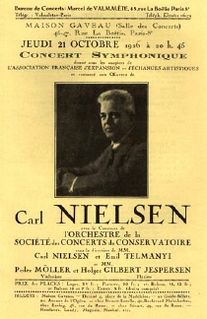
Carl Nielsen's Concerto for Flute and Orchestra was written in 1926 for Holger Gilbert-Jespersen, who succeeded Paul Hagemann as flautist of the Copenhagen Wind Quintet. The concerto, in two movements, was generally well received at its premiere in Paris in October 1926 where Nielsen had introduced a temporary ending. The first complete version was played in Copenhagen the following January. The flute concerto has become part of the international repertoire.
The Concerto Fantasy for Two Timpanists and Orchestra is a double timpani concerto written by Philip Glass in 2000. It is paired with the Cello Concerto on Vol. I of Glass' Concerto Project, a set of eight concerti by the composer. A typical performance of the work lasts 25–28 minutes. It was written for Jonathan Haas and later recorded by Evelyn Glennie, and was premiered by Haas and Svet Stoyanov with the American Symphony Orchestra in Avery Fisher Hall, Lincoln Center, conducted by Leon Botstein. The work was commissioned jointly by the American Symphony Orchestra, the Peabody Symphony, the Milwaukee Symphony, the St. Louis Symphony and the Phoenix Symphony. In 2004, a transcription for wind ensemble was written by Mark Lortz, which debuted at Peabody Institute in 2005.
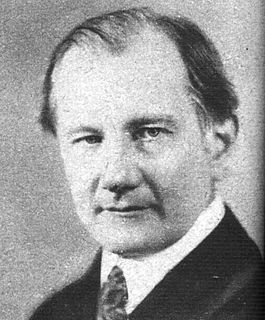
The Symphony No. 2 in E, Op. 40, was completed by Ernő Dohnányi in 1944, at the close of the Second World War. It was revised later in the 1950s. Written with audible roots in the Romantic tradition, the work is largely lyrical, yet maintains a controlled militaristic air inspired by the events surrounding its composition. It references a variety of musical backgrounds, including the work of Brahms, Wagner, Kabalevsky, and Bach. Bach's song Komm, süßer Tod serves as the basis for a significant portion of the finale.
The Rondo for Violin and Strings, D 438, is a composition in A major by Franz Schubert. He wrote the rondo in 1816. Like the roughly contemporary Adagio and Rondo concertante in F major, D 487, the work is a concertante piece designed to highlight the skills of the violin soloist.

The Concerto for Piano, Violin, and Strings in D minor, MWV O4, also known as the Double Concerto in D minor, was written in 1823 by Felix Mendelssohn when he was 14 years old. This piece is Mendelssohn's fourth work for a solo instrument with orchestral accompaniment, preceded by a Largo and Allegro in D minor for Piano and Strings MWV O1, the Piano Concerto in A Minor MWV O2, and the Violin Concerto in D minor MWV O3. Mendelssohn composed the work to be performed for a private concert on May 25, 1823 at the Mendelssohn home in Berlin with his violin teacher and friend, Eduard Rietz. Following this private performance, Mendelssohn revised the scoring, adding winds and timpani and is possibly the first work in which Mendelssohn used winds and timpani in a large work. A public performance was given on July 3, 1823 at the Berlin Schauspielhaus. Like the A minor piano concerto (1822), it remained unpublished during Mendelssohn's lifetime and it wasn't until 1999 when a critical edition of the piece was available.

The Concerto no. 4 for Violin and Orchestra is a violin concerto by Soviet and German composer Alfred Schnittke. It was commissioned by the 34th Berlin Festival and written in 1984. Its first performance was given in Berlin on 11 September 1984 with dedicatee Gidon Kremer as soloist and the Berlin Philharmonic Orchestra conducted by Christoph von Dohnányi.